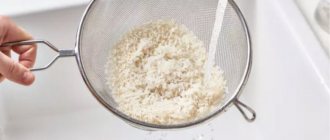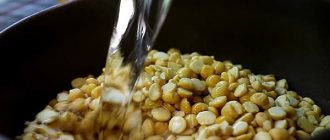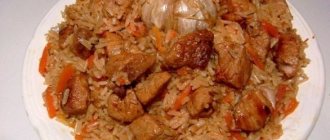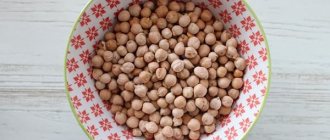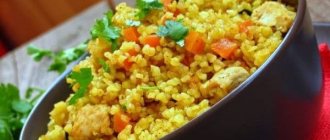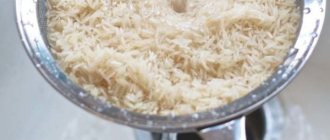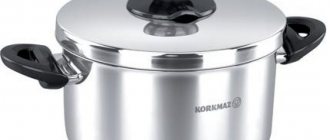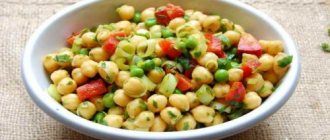Even a novice housewife knows that rice needs to be washed before cooking various dishes. An advanced level involves soaking different types of rice to improve the consistency of porridge or pilaf, increasing the nutritional value of the cereal and its taste. How to soak rice for pilaf and porridge, what features do steamed, red and brown varieties of cereal have? This knowledge will help housewives to significantly improve their culinary achievements.
How to wash rice for pilaf
Some novice housewives are tormented by the question of how to rinse the cereal so as not to make the taste of the future pilaf worse?
Before washing the rice grains, you should remember some simple rules:
- You need to wash the cereal in clean and filtered water. Namely, tap water is not suitable for such a process. Why? Such water contains harmful elements and foreign odors, with which the cereal is immediately impregnated during the first rinsing.
- You should use warm or ice water, it depends on the type of cereal. Processed grains are usually washed in warm liquid. Expensive rice varieties (basmati, jasmine, red and brown rice) are washed in ice water. Basmati only needs to be doused with water; other types of grains need to be washed until the water is clear.
- Rice grains must be washed at least 6 times. One or two sinks is not enough. It is very important that all foreign elements contained in it are washed out of the rice. For this purpose, thorough rinsing is necessary.
- If necessary, soak the cereal. And definitely, in drinking clean water. For this purpose, heated water to approximately 65 C is used. It will better remove excess starch. In addition, warm water is much easier to absorb into the grains, so the rice grains will absorb less oil during cooking, and the pilaf will turn out to be a light and dietary treat. The optimal holding time is about half an hour. And it is strictly forbidden to pour boiling water over the cereal: the side dish will turn into a boiled lump.
- The grains should be washed after soaking. Even cold tap water will do for this purpose. Place the cereal in a cup, add water, stir with a spoon. Next, drain the liquid. And this procedure should be repeated several times.
That's all. Well-washed rice is ready for cooking. Rest assured: every treat prepared from properly washed cereal will be tender and quite nutritious.
Yandex pictures
Beneficial features
This composition makes brown rice a healthy dietary supplement. After all, it helps rid the body of toxins, lowers blood sugar levels, prevents inflammatory processes in the intestines, helps eliminate neuroses, and facilitates the functioning of the human circulatory system.
Therefore, brown rice is indispensable in the diet for the following diseases:
- salt deposits;
- diseases of the cardiovascular system;
- vitamin B1 deficiency;
- diabetes;
- inflammation of the gastrointestinal tract;
- eczema and dermatitis;
- problems with the nervous system.
Naturally, if you have any disease, you cannot refuse medical help, relying only on the properties of brown rice. With appropriate treatment, it will only help speed up the healing process.
But regular consumption of brown rice will help normalize all metabolic processes in the body. And this will not be slow to manifest itself in appearance.
It is not for nothing that brown rice is included in the secret arsenal of beauties with radiant skin and silky hair.
All these beneficial properties of brown rice during the grinding procedure disappear or are greatly reduced in its white, refined counterpart. In addition, white rice contains more carbohydrates than brown rice.
It can be argued that white rice tastes more tender and pleasant than brown rice, and that its appearance is more refined. That white rice can be cooked faster, easier and more varied than coarse, unpolished rice. No one is going to argue with this.
You just need to understand that these are two different products that need to be used independently of each other, without forgetting about the priorities of a healthy diet.
Do I need to soak rice for pilaf?
After carrying out many studies, scientists found that the cereal contains a large amount of starch. This affects its viscosity in making most treats. This especially applies to pilaf. The more starch there is in the cereal, the worse it is for the pilaf. Because we are already accustomed to seeing golden brown buttery rice soaked in lamb fat. Starch prevents rice grains from being soaked, making the grains dry. Therefore, before you start preparing pilaf, the cereal should be soaked in warm, clean water.
1 hour is enough for the grains to increase in volume, crack along the edges and free themselves from excess starch. It is precisely into these very cracks that oil or fat fully penetrates and saturates the treat. When soaking cereal, it is preferable to change the water at least 2 times. In clean water, the side dish releases starch much better.
If you take this into account, literally after a quarter of an hour the grains will begin to increase slightly in volume. This means that it will take less time to cook in a cauldron.
How to properly soak rice for pilaf:
- Only clean running water is used.
- Soak in a glass container.
- Before the process, all the grains are thoroughly washed so that all excess is removed with the liquid.
- The dishes are left on the table.
- Before cooking, the cereal is washed again.
These are the simple rules for working with the most famous grain, which will help you prepare the most delicious porridges and crumbly dishes.
Many housewives advise soaking the cereal in salt water. The cereal will absorb as much salt as needed.
Recipe Description
Azerbaijani-style pilaf with basmati rice greatly depends on the quality of the rice. After all, there is practically nothing in this dish except cereal. Therefore, it needs to be given maximum attention, and also flavored with the best ghee (can you feel the Iranian note in the preparation - a lot of butter, saffron and dried fruits?).
Another feature is the base for the rice; it is made of simple unleavened dough and is placed on the bottom of the cauldron so that the rice does not burn when simmering. Imbued with the aromas of saffron and butter, this crust is extremely tasty.
The essence of this recipe is to cook the rice separately and simmer it with butter and dried fruits. You can mix the ingredients in a plate.
For those who are accustomed to traditional meat pilaf, below is a description of the recipe for how to prepare pilaf from rice, basmati and chicken.
How long
Having soaked the cereal overnight (for 7-8 hours), in the morning it will definitely be ready for making pilaf. But the hardness of the grains should be taken into account. If they are not completely solid, and they will get wet for a long time, then even before the liquid boils, they will be able to boil. Therefore, this method is only suitable for solid species. Some soft types are saturated after 30 minutes, while other hard ones, for example, devzira and basmati, after a few hours. Over the years, one begins to understand how long each variety needs to be aged.
If you keep the cereal in hot water, only 2 hours is enough, if in cold water – from three hours. It is recommended to soak red rice for 3-5 hours - the boiling time will noticeably decrease. The brown variety of cereal requires a special approach - it is hard, and for cooking it is worth soaking it for 8-12 hours.
pixabay.com
Amount of water
It really can be difficult. For white rice (long grain, basmati, jasmine), use 1 cup of grain per one and a half or 1 and 3/4 cups of water.
With brown rice, the ratio is 2 to 1. 2 cups of water or broth to 1 cup of grain. Wild rice takes longer to cook and requires more water, so use 3 cups of water per 1 cup of grain.
Do I need to soak parboiled rice?
The steamed variety is the easiest for kitchen masterpieces. How long will such peeled grains last to become the most crumbly side dish? The answer is from 30 to 2 hours.
Red rice
This type of cereal is soaked for 3-5 hours. Moreover, we should not forget that after this process, the time for boiling rice is reduced by almost 2 times.
Yandex pictures
Brown (brown) rice
This cereal needs a special approach: if it is not soaked, it simply will not cook. The shells of the grains are quite rough and contain a large number of inhibitors. To cook brown rice, you need to soak it for at least 8-12 hours.
Yandex pictures
Negative qualities
Excessive indulgence in any product can be harmful to health. So before you become a brown rice fan, there are a few things to consider.
Often, suppliers and manufacturers of brown rice, given the increased demand for this product, simply tint white rice.
To avoid disappointment when using such a product, you should not buy it from private sellers.
Large manufacturers treat rice with glucose and talc before transporting it, which can be harmful to health if consumed for a long time.
Delicious recipe! Recipe for fish pie dough in the oven
We should not forget that the amount of dangerous fertilizers in countries that practice industrial rice cultivation is very different from the standards familiar to Russians.
If you purchase a large batch of brown rice, then during long-term storage it can not only lose some of its beneficial properties, but also its nutritional value.
Therefore, a number of conditions must be met:
- store in small batches;
- maintain a cool temperature in the room where the product is stored;
- keep the rice in a well-closed ceramic or tin container;
- When storing, avoid high humidity, which can spoil the cereal.
A few recommendations for delicious pilaf
Knowing how to properly make a side dish is quite important. But this is not all that is needed to make real pilaf that your family and friends will admire. Here are some more useful tips that will certainly be very useful to you:
- Some chefs use beef to make pilaf. But this is not the best choice, since the dish turns out too dry. It is much better to take beef or pork. Chicken is also allowed if that's your preference.
- The oil used is important. Uzbeks always take two - cotton and sesame, and also always add fat tail fat. This results in a richer aroma.
- To ensure a successful pilaf, it is recommended to use a cast iron, copper or aluminum cauldron. This may seem unusual, but the material of the cookware has a great influence on the taste of the dish.
These tips can help you make the perfect pilaf that has amazing texture and flavor. Stick to them, and you can please your family with an incredibly tasty dish, using the cheapest grains and spending a minimum amount of time and effort.
So, rice should definitely be soaked. The purpose of washing and soaking grains is well known: the grain is cleared of unnecessary starch, acquires an interesting shade, becomes crumbly and makes the taste of the dish more vibrant and appetizing. The suitable temperature for soaking in water is 60 C. Steamed rice grains can also be soaked, but this is not necessary. In addition to everything, you need to wash any grains. First, this is used for hygienic purposes - to clean dust, dirt and possible chemicals. substances.
pexels
Preparation
It would be wrong to pour rice into the zirvak without preparation. To make pilaf and not porridge with meat, the rice needs to be prepared.
Do not use a colander to soak rice
How to soak
It is necessary to wash the rice. This is to remove starch powder, which will turn into a paste in the finished dish. In addition, there may be dust, chemicals and other nasty things on the surface of the cereal.
Long grain rice varieties are easy to break when washed. It's better not to interfere with your hands at all, let running water do all the work. And only when this is not enough, is it permissible to stick your palm under the rice and stir it to help wash it.
Do not rub the rice between your palms when washing.
You need to rinse until you get clean water. Completely clean.
If it didn't work out
So, what you feared happened: it turned out to be tasty, but a porridge with meat. There is nothing that can be done to correct anything at this point. But you need to draw conclusions and not give up culinary experiments.
The rice in the pilaf may stick together, or, on the contrary, it may be dry.
Why does it turn out like porridge?
Pilaf turns into mush for several reasons. Rice grains lose their shape:
- More water than necessary. For example, rice was soaked longer than necessary or excess water was poured into the pilaf.
- The pilaf was overcooked.
- The rice was originally crushed. Or, when washing, long grain rice was broken by rubbing it between the palms.
- Poor quality washing of rice, and rice powder got into the pilaf.
- Starchy variety. Here, either refuse such rice or try to fry it before preparing pilaf.
- We disturbed the pilaf with a slotted spoon, and the cooked rice crumbs fell into the broth and thickened the pilaf.
- And often, the recipe is violated, the proportions and temperature conditions are not followed.
If you are unsure of your abilities, but want to cook pilaf, we recommend starting with steamed rice - it is difficult to make it sticky.
Popular types
Uzbek pilaf in a cauldron
From the huge variety of types, we will consider the most famous and recognizable products that are purchased in retail supermarkets or ordered online in online stores.
Basmati, "the world's rice king". Long grain rice, grown in India and Pakistan, has a delicate floral aroma, its long thin grains smelling of sandalwood oil. It has a delicate structure with a pronounced nutty taste. Used in hot and spicy foods of the Middle East, it is used to prepare delicious side dishes and main dishes. This variety of grain is the longest and most expensive.
Arborio. The Italian coarse-grained variety has a special property - after the starch is separated from the grains, the core remains solid; this variety is suitable for preparing the well-known risotto. To prepare the rice, do not cook it until completely cooked, but cook it after removing it from the oven. The grain remains dense inside, and the dish retains a light nutty flavor and delicate creamy structure.
Camolino. Very tasty, sticky rice. The texture is ideal for preparing many dishes according to oriental recipes. In recent years, it has been used as a side dish; rice dishes with vegetables are considered especially tasty; the kernel filling is used in aromatic oven-baked pies.
Jasmine, "Asian rice", is a popular Thai white product. It is very rich in starch, so before use it is washed several times in cold water. It is considered a more affordable substitute for basmati; it is used in the preparation of many Asian dishes; salads, side dishes, and desserts are prepared on its basis. It is aromatic, sticky, in boiling water the kernels retain their shape, are soft, and the dish is crumbly, not overcooked.
Wild rice, American variety. It is grown in the only place - on the Great Lakes of America, where harvests of this variety are harvested. It has a light nutty aroma and a pleasant sweet taste. The composition contains dietary fiber, vitamins, folic acids, and useful minerals. Dishes made from black wild rice are satisfying, low in calories, and balanced in healthy elements. To add piquancy to food, long grains of rice are added to salty and sweet dishes. American rice has a positive effect on the human digestive tract and nervous system.
Subtleties of cooking
Next, we’ll find out how to properly soak rice for pilaf and whether it needs to be washed after that.
Pilaf, as you know, is boiled rice soaked in oil. Rice cereal contains a lot of starch, which, when cooked, releases a paste into the water and turns the dish into a sticky mush. This substance prevents oil from penetrating into the rice grains. So it turns out that the porridge separates from the oil, and the dish does not live up to expectations.
In order for the rice grains to be crumbly after cooking and not look like glue, the rice for pilaf needs to be soaked.
